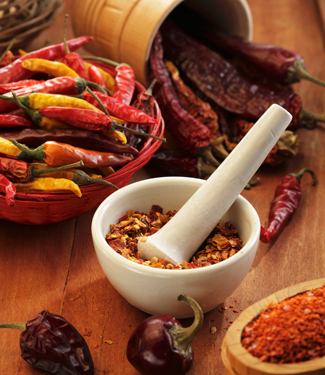Sold in cellophane bags fit to burst with fiery red peppers, the large selection of dried chiles available at markets catering to Mexican and Central American cooks can be daunting. When taking on a new mole recipe with a long list of ingredients, it’s hard to know which ones to use – though they’ll keep for several months sealed in airtight containers and stored in a cool dry place while you figure it out.
Hard to tell apart, dried peppers should be uniform in color and free of any mildew or transparency in the skin. They should be wiped clean before using and retain some flexibility. Toasting brings out the flavors in many chiles, but they burn through quickly and need to be watched carefully. If this seems like too much trouble for a little heat, then you’re underestimating the wonderful complexity chiles bring to even the simplest dishes. Here are a few of the most widely available varieties. [pagebreak]
Ancho Chile
Barely sweet, anchos are the perfect gateway chile. These dried, ripe poblanos are mild but the seeds and veins should be removed before using so they do not overwhelm other flavors. Perfect for chiles rellenos, adobos, and moles, they can also be ground into a powder that pairs well with chocolate in baked goods. Anchos are often confused with, and can be substituted for, the darker and even sweeter mulato chile that comes from the purple poblano.
Chile de Árbol
Retaining their deep red color even after drying, smooth and slender árbol chiles may be decorative but they still manage to bring the heat. Bright and acidic, they are typically used whole and added to cooked sauces, soups, and stews. A close relative of cayenne peppers, they’re often stemmed, seeded, toasted, and ground into a fiercely hot chili powder. [pagebreak]
Chipotle Mora Chile
Perhaps the most well known and versatile chile, chipotles are red jalapeños that have been smoked and dried, deepening the flavor. Wrinkled and dark reddish brown, they are widely sold canned in adobo sauce and can be used in the same way as the plain dried chiles. The seeds and veins do not need to be removed before adding to recipes like albóndigas al chipotle or bringing smoke and spice to seafood.
Guajillo Chile
These deep burgundy chiles, about 5 to 6 inches long, range from mild to medium heat and have a complex woodsy quality that is more smoke than fire. Derived from fresh mirasol peppers, they mostly grown in central and northern Mexico and rival anchos in popularity. Smooth, tough-skinned, and tapered, they are commonly soaked before being blended into sauces, pastes or rubs for meat and poultry. For added heat, substitute puya (also sold as pulla) chiles.
Pasilla/Pasilla Negro Chile
Pasilla translates to “little raisin” and, in this case, there is a lot to the name. Wrinkled and nearly black, these chiles come from dried chilacas and have a subtle fruitiness that plays out well in elaborate moles and rich sauces. Also known as pasilla negro, they are about 6 to 7 inches long and range from moderate to hot. Quickly fried, they puff up nicely and can be crumbled as a garnish for soups and stews.


![Making Mealtime Matter with La Familia: Easy Sofrito [Video]](https://thelatinkitchen.com/wp-content/uploads/2015/10/sofrito-shutterstock__0-500x383.jpg)
![Easy Latin Smoothies: Goji Berry Smoothie [Video]](https://thelatinkitchen.com/wp-content/uploads/2015/12/goji_berry-shutterstock_-500x383.jpg)
















![Fun and Fast Recipes: Fiesta Cabbage Salad [Video]](https://thelatinkitchen.com/wp-content/uploads/2015/11/fiesta_cabbage_slaw-shutterstock_-500x383.jpg)









